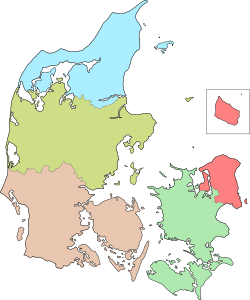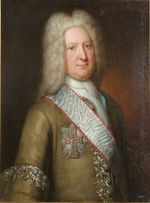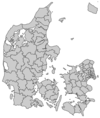مناطق الدنمارك
مناطق الدنمارك الخمس أُنشئوا ككيانات ادارية على مستوى فوق البلديات وتحت الحكومة المركزية في القطاع العمومي كجزء من الإصلاح البلدي الدنماركي 2007، حين ألغيت الثلاثة عشر مقاطعة (amter). At the same time, the number of municipalities (kommuner) was cut from 270 to 98.
Each region is governed by a popularly elected regional council with 41 members, from whom the regional chairman is chosen.
The main responsibility of the regions is healthcare. Lesser powers of the regions include public transport, environmental planning, soil pollution management and some coordination of secondary education.
In contrast to the former counties (1970 - 2006), the regions do not have municipal powers. Regions cannot levy taxes, but are financed partly by block grants from a tax levied by the central government until 2018 (sundhedsafgift, i.e. health tax) and partly by taxes collected by their constituent municipalities. Regions cannot decide their budgets independently, but must use the block grant for the purposes that are specified by the state. As they are not municipalities, regions are not allowed to have coat of arms, but they do have modern logos.
The small archipelago of Ertholmene to the northeast of بورنهولم is not part of any region or municipality. Its inhabitants do not pay municipal taxes, nor did they pay the central government's health care contribution tax (2007 until 2018) or the tax levied by counties prior to 2007.
The representative organisation Danske Regioner was set up on 23 March 2006. It is an advocacy and lobbying organisation speaking on behalf of all of the regions, including negotiating labour contracts, etc. The organization also maintains an office in بروكسل. As a central representation of the Danish healthcare system it has rather large, although unofficial, powers. Its equivalent before 2006 was Amtsrådsforeningen, the organisation of county representations.
قائمة المناطق
| الاسم الدنماركي (الترجمة الحرفية) | Self-appellation in English1 | مقر الادارة (أكبر مدينة لو مختلفة) | الرئيس | التعداد2 (2018-01-01) |
المساحة الإجمالية2 (كم²) |
الكثافة السكانية (/ كم²) |
المقاطعات السابقة (1970–2006) |
|---|---|---|---|---|---|---|---|
| منطقة هوڤدستادن ("منطقة العاصمة") | منطقة العاصمة الدنماركية[1] | Hillerød (كوبنهاگن) | Sophie Hæstorp Andersen | 1,822,659 | 2,546.3 | 715.8 | المقاطعات:كوبنهاگن، فردريكسبورگ؛ البلديات: كوبنهاگن، فردريكسبرگ، بورنهولم |
| Region Midtjylland ("منطقة وسط يوتلاند") | منطقة وسط الدنمارك[2] | ڤيبورگ (آرهوس) | Anders Kühnau | 1,313,596 | 13,000.2 | 101.04 | Ringkjøbing، تقريبا كل آرهوس، والجزء الجنوبي من ڤيبورگ والجزء الشمالي من Vejle |
| Region Nordjylland ("إقليم شمال يوتلاند") | منطقة شمال الدنمارك[3] | آلبورگ | Ulla Astman | 589,148 | 7,874 | 74.82 | شمال يوتلاند والجزء الشمالي من مقاطعة ڤيبورگ وجزء صغير من مقاطعة آرهوس |
| Region Sjælland ("إقليم زيلاند") | منطقة زيلاند[4] | Sorø (رسكيلا) | Heino Knudsen | 835,024 | 7,217.8 | 115.68 | رسكيلا، Storstrøm، وغرب زيلاند |
| Region Syddanmark ("منطقة جنوب الدنمارك") | منطقة جنوب الدنمارك[5] | Vejle (أودنسه) | Stephanie Lose | 1,220,763 | 12,191 | 100.13 | فونن، Ribe، جنوب يوتلاند والنصف الجنوبي من Vejle County |
| Danmark (الدنمارك) | N/A | كوبنهاگن | N/A | 5,781,190 | 42,894.8 | 134.77 | (مقاطعات الدنمارك) |
1 الأقاليم نفسها تستخدم الأسماء الإنجليزية التي قد لا تكون بالضرورة ترجمة حرفية للاسم الدنماركي.
2 أرقام المساحة والتعداد مجموعهم لا يساوي المجموع الكلي. مساحة الأرض: 42,394 كم². مساحة المياه الداخلية: 500 إلى 700 كم². Ertholmene مُتضمَنة في الإجماليات. Statistikbanken.dk/FOLK1A.
التاريخ
The predecessor of the state administration(s), from 1970 until the 2007 reform, were the 14 county government divisions or prefectures (Danish: statsamt, plural: statsamter, i.e. 'state county'). They were each led by an amtmand (county prefect or governor) appointed by the government, while in ecclestiastical contexts the title stiftamtmand ('diocesan prefect') was used for the same position. These units were distinct from the 14 counties led by an elected council, but covered the same areas. Copenhagen, however, had the equivalent entity of Upper Presidium (Københavns overpræsidium) led by an upper president (overpræsident), a title originating from 1747. The municipality of Frederiksberg shared its county governor and county government division with Copenhagen County (not covering Copenhagen proper, but the surrounding area). Bornholm retained its county government office and governor even after losing its county status (2003-2006).
While prefect or governor is an English rendering of the title, county prefects were practically senior government officials, unknown to a larger public and less powerful than governors in many other countries. On the Faroe Islands and Greenland, after autonomy, the equivalent representative of the Danish government is the High Commissioner, (rigsombudsmand, formerly amtmand, which was often translated as governor).
The general public is mostly familiar with the former statsamt and present statsadministration as the entity dealing with divorce and child custody.
The position of county prefect dated back to the age of absolutism. After elected councils were introduced, the King-appointed county prefect still led the elected county council and had larger political influence. In 1970, his political role was then taken over by the county mayor (amtsborgmester) who was one of the elected county council members. The county prefect remained as the highest government representative in each county, and in his traditional civil servant uniform would be the person to receive the Queen on her visits throughout the country. In Copenhagen Municipality, the switch was made in 1938 when the title of Lord Mayor of Copenhagen (Københavns overborgmester, literally 'upper mayor of Copenhagen') was created for the elected leader of the city council. The equivalent of the Danish county prefect is the Swedish landshövding and the Norwegian fylkesmann.
انظر أيضاً
- قائمة المناطق الدنماركية حسب مؤشر التنمية البشرية
- بلديات الدنمارك
- تقسيمات البلدان النوردية
- جزر فارو
- گرينلاند
- NUTS statistical regions of Denmark
- ISO 3166-2:DK
المراجع
وصلات خارجية
- Danish Regions Official homepage (13. February 2013). Retrieved on 9 August 2014.
- Danish Ministry for Economic Affair and the Interior - Statistics department Statistical information about Danish regions and municipalities (دنماركية)
- Explanation of and background for Municipal Reform – with links to the Danish Ministry of the Interior and Health (إنگليزية)
- The agreement on the Municipal Reform – from the Danish Ministry of the Interior and Health (دنماركية)
- The Ministry´s home page with report from the Commission on Administrative Structure etc.
- Home page of Regions. Click on map to access a Region's home page (دنماركية)
- Budget of the Regions(دنماركية)
- Statistikbanken.dk Budget
- Statistikbanken.dk Budget(دنماركية)
- English home page of State Administrations
- Areas of concern (adoption etc.) (إنگليزية)
- Ministry of Employment
- Links to the 4 employment regions(دنماركية)
- Regionalization and devolution: Proposed new regions of Norway (powerpoint slide show)
- Maps (pdf) showing local/regional administration 1660-2007(دنماركية)
- Map with named municipalities and regions
- Krak searchable/printable map(outline of municipality visible, but does not print out!)
- Statistics Denmark
- Region Danmark



